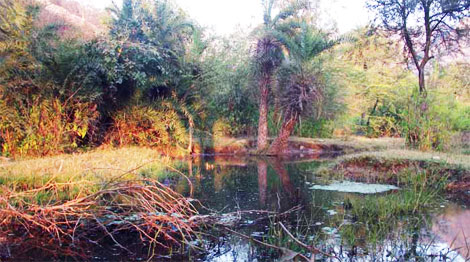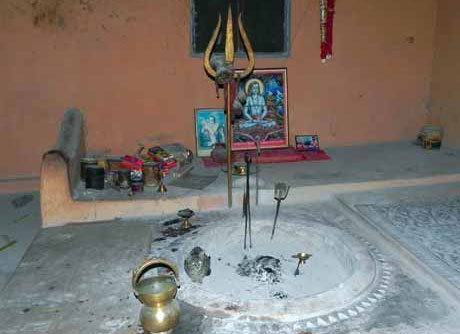

Community-managed sacred groves, vital biodiversity reserves, face extinction
By Adnan Faisal and Showvik Das Tamal

Photo: Showvik Das Tamal
Awalk through the mustard fields of
the village Pagdandi, and one
finds oneself in a lush green
grove. The air is laden withe aroma of
wet soil, and trees of khair, ber, ket and
date flourish. One cannot believe that
while a stream runs through the grove,
there are parts of Rajasthan adjacent to
this very spot where there is very little
rain and no water. This forest if one of the
25,000 Orans or ʻDev vanʼ in Rajasthan.
Sacred community forests
The Chursiddhi Oran, one of the many
Orans in Siliser Cheend, near
Bakhatpura village of Alwar acts as a
micro bio-diversity reserve and is a
community managed ecosystem. These
local forests vary in size from a hunded
to five hundred bighas, and usually
contain a source of water. Each Oran is
associated with a deity, hence the name
ʻdev vanʼ or abode of God.
These community managed groves epitomise a centuries old tradition of forest and water conservation.
Nanak Ram Gujjar (72) of Bhakhatpura describes a seven member elected committee, traditionally known as Thain, that makes rules and regulations to regulate the management and use of natural resources from the Oran. It is mandatory for all villagers to follow collective decisions.
A Saint (Mahatma), usually from
another village, is entrusted with the
responsibility of guarding and preserving
the Oran, and enforcing the rules laid
down by the Thain. His primary duty
however is to take care of the shrine of
the deity of that particular Oran.
Orans have a series of water
harvesting structures made by the
community. An upstream dam of loose
boulders, some earthen johads or
bunds, and finally a masonry check dam
are used to obstruct the rapid runoff
after rainfall. As the area is usually dry
sloping land prone to soil erosion, these
bunds and check dams also help
prevent soil loss. In turn, the increased
percolation allows the recharge of the
water table, and provides surface water
which is used for agriculture or livestock
needs. The ample soil moisture
encourages plant growth and provides
subsistence for fauna, and livelihood
needs of the local livestock dependent
communities.
Orans are a source of fodder, fuel,timber, berries, roots and medicinal herbs. Grazing of livestock is done in turns and in certain seasons, and minor forest produce can be collected only with permission and not for commercial purposes.
Shrinking heritage
However, it is unfortunate that these
Dev vans are facing a threat. The
traditional practice of conserving Orans
is in danger as many Orans have
degraded, shrunk, dried up or been
diverted for non forest uses. The
Chursiddhi Oran is one of the few
revived by collective efforts of
community and with help from
KRAPAVIS (Krishi Avam Paristhitiki
Vikas Sangathan), an NGO led by
Aman Singh.
Singh explains that legally Orans
were once categorized as cultivable
wasteland. Since the 1950ʼs these were
divided into protected forest land and
revenue land. Now, Orans are classified
as being revenue land and communities
have no ownership over them. Now,
this land is often diverted by the
government for mining or other nonforest
purposes without consulting the
communities dependent on these
groves, rendering them devoid of
access to natural resources and
pushing towards further marginalization.
Silver lining
The Rajasthan Forest Policy, 2010
for the first time included a section
on Orans. It recognizes Orans as
community managed systems which
would be provided necessary legal and
financial support. It also envisages the
preparation of a district-wise database
and inventory of Orans. So effectively,
communities have now acquired a
bargaining power and a voice to prevent
any future diversion of these sacred
groves in arbitrary manner.
However, the ownership comple -
xities have not been addressed and the
land continues to be government
owned. Further, the policy allows
formation of a committee consisting of
local members or temple trustees for
managing the Orans. This would
institutionalize the committee as a body
parallel to Panchayati Raj Institutions or
PRIs which can give rise to conflicts. At
the moment, Panchayat agrees to
decisions of the committee in matters
of Oran. This is also because of the fact
that Thain also have representatives
from Panchayats.
The committee mentioned is not mandated to be elected and therefore runs the risk of domination by socially dominating castes. In Chursiddhji Oran managed by two major castes Meena and Gujjar, conflicts have recently arisen. Notwithstanding these concerns, the Rajasthan Forest Policy has gives.

Photo: Showvik Das Tamal
Further legislation and regulations to facilitate independent and fearless management of Orans are required. Orans are sacred and integral to the way of life of these communities.
Their significance can only be understood by witnessing the landscape itself, and the close relationship its communities have with it.



